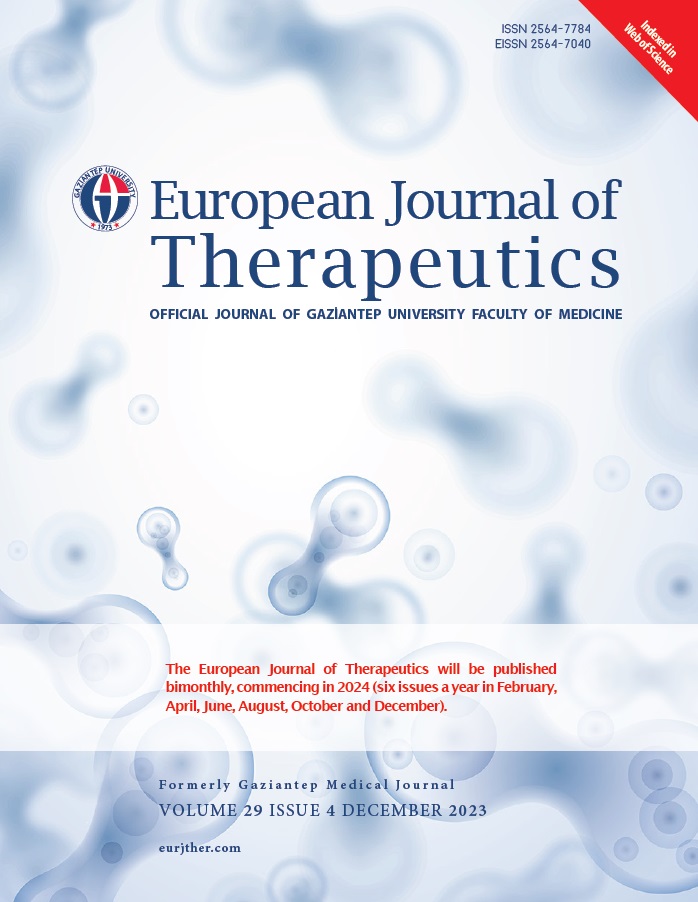Comparison of Topical Treatment Preferences of Physicians in Dermatological Diseases
DOI:
https://doi.org/10.58600/eurjther1859Keywords:
antibiotics, prescription, family physician, GlucocorticoidsAbstract
Objective: Regardless of their specialty, physicians frequently encounter dermatological conditions. We aimed to determine the topical medication choices of physicians for various dermatoses and to identify differences in preferences between dermatologists and non-dermatologist physicians.
Methods: Using an online survey, physicians were asked to select three preferred topical antibiotics/antiseptics, antifungals, and corticosteroids when treating a pyoderma, dermatophytosis, or a dermatosis necessitating topical corticosteroid therapy. Statistical analysis was performed using Statistical Package for the Social Sciences v.27.
Results: Among 358 physicians, 24.0% were dermatologists, and 76.0% were non-dermatologist physicians. The mean age was 38.40, and the average duration of medical practice was 14.04 years. The most frequently chosen topical antibacterials were fusidic acid (74.3%) and mupirocin (65.9%); topical antifungals were isoconazole nitrate + diflucortolone valerate (56.4%), tioconazole (27.7%), and naftifine (25.1%); and topical corticosteroids were clobetasol propionate (38.5%), methylprednisolone aceponate (36.6%), and mometasone furoate (34.6%). Dermatologists used nitrofurazone and izokonazol nitrate + diflucortolone valerate less frequently compared to non-dermatologists (0% vs. 27.6% and 8.1% vs. 71.7%, respectively; p-values <0.001). Family physicians/general practitioners constituted the largest group selecting clobetasol propionate (28.3%).
Conclusion: Physicians in our country predominantly choose fusidic acid and mupirocin as topical antibiotics, aligning with existing literature. However, nitrofurazone, causing contact dermatitis, and corticosteroid-containing antifungals with the potential for complications due to inappropriate use are frequently preferred by non-dermatologist physicians but not by dermatologists. The bold choice of clobetasol propionate, an ultrapotent topical corticosteroid, by family physicians/general practitioners is an important issue to address during medical education and post-graduation.
Metrics
References
Stern RS, Nelson C (1993) The diminishing role of the dermatologist in the office-based care of cutaneous diseases. J Am Acad Dermatol. 29:773-777. https://doi.org/10.1016/0190-9622(93)70243-m
Feldman SR, Fleischer AB Jr, Chen JG (1999) The gatekeeper model is inefficient for the delivery of dermatologic services. J Am Acad Dermatol. 40:426-432. https://doi.org/10.1016/s0190-9622(99)70492-5
Özyurt K, Sucaklı MH, Çölgeçen E, Çelik M (2014) Knowledge of family physicians on common dermatological diseases and their diagnosis and management trends. Turk Arch Dermatol Venerol. 48:254-262.
Özçelik S (2021) Nitrofurazona Bağlı Alerjik Kontakt Dermatit: 22 Olgudan Oluşan Bir Çalışma. Balıkesir Medical Journal. 5:18-22.
Bandyopadhyay D (2021) Topical Antibacterials in Dermatology. Indian J Dermatol. 66:117-125. https://doi.org/10.4103/ijd.IJD_99_18
Koning S, van der Sande R, Verhagen AP, van Suijlekom-Smit LW, Morris AD, Butler CC, Berger M, van der Wouden JC (2012) Interventions for impetigo. Cochrane Database Syst. Rev 1:CD003261. Published 2012 Jan 18. https://doi.org/10.1002/14651858.CD003261.pub2
Kreft B, Wohlrab J (2022) Contact allergies to topical antibiotic applications. Allergol Select. 6:18-26. Published 2022 Feb 1. https://doi.org/10.5414/ALX02253E
Bonamonte D, De Marco A, Giuffrida R, Conforti C, Barlusconi C, Foti C, Romita P (2020) Topical antibiotics in the dermatological clinical practice: Indications, efficacy, and adverse effects. Dermatol Ther. 33:e13824. https://doi.org/10.1111/dth.13824
Bilgili SG, Ozaydin-Yavuz G, Yavuz IH, Bilgili MA, Karadag AS (2019) Cutaneous reactions caused by nitrofurazone. Postepy Dermatol Alergol. 36:398-402. https://doi.org/10.5114/ada.2019.87444
Arıcan Ö, Gürsel Y, Gürsel Y (2009) Üç Tinea İnkognito Olgusu. Balkan Medical Journal 2009: 78-82.
Baş VN, Çetinkaya S, Yılmaz Ağladıoğlu S, Peltek Kendirci HN, Aycan Z (2010) Topikal Steroide Bağlı İyatrojenik Cushing Sendromu. Çocuk Dergisi 10:152-155.
Akkuş Y, Baş VN, Yılmaz Z (2020) Cushing syndrome induced by long term use of corticosteroids in the management of atopic dermatitis. [Zespół Cushinga wywołany długotrwałym stosowaniem kortykosteroidów w leczeniu atopowego zapalenia skóry] Pediatr Endocrinol Diabetes Metab. 26:216-219. https://doi.org/10.5114/pedm.2020.100803
Pels R, Sterry W, Lademann J (2008) Clobetasol propionate--where, when, why?. Drugs Today (Barc). 44:547-557. https://doi.org/10.1358/dot.2008.44.7.1122221
Thakran P, Agrawal S, Singal A, Verma S, Madhu SV (2021) Iatrogenic Cushing's Syndrome in Patients with Superficial Dermatophytosis. Indian Dermatol Online J. 12:237-243. Published. 2021. Mar 2. https://doi.org/10.4103/idoj.IDOJ_432_20
Downloads
Published
How to Cite
License
Copyright (c) 2023 European Journal of Therapeutics

This work is licensed under a Creative Commons Attribution-NonCommercial 4.0 International License.
The content of this journal is licensed under a Creative Commons Attribution-NonCommercial 4.0 International License.


















